
One of the unexpected highlights of our three weeks in the Balkans was lovely Istria — the heart-shaped, Italian-flavored peninsula of western Croatia.
Dave and I ended up here on a bit of a whim. We were deciding whether it would be best to fly into Zagreb, Split, or somewhere else entirely — and it was cheapest to fly into Pula.
Pula? We can work with that, I thought. I’d read a bit about Istria, and I know that both Mike of Go, See, Write and Akila of The Road Forks were fans. So Pula it was.And we were plunged into an absolutely gorgeous atmosphere of hill towns and seaside villages, dramatic beaches and rose gardens, and absolutely delicious wine, olive oil, and truffles. We knew we’d have a great time, but we had no idea Istria would be this good.
First of all, where’s Istria?
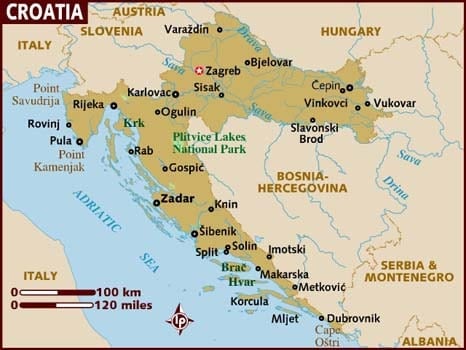
It’s that bump on the left! Pula is Istria’s largest city and where the air hub is.
Istria is Croatia’s Italian region — and not just because it has a large Italian population. The pastel-colored seaside towns of Istria could be straight out of Liguria; the rustic hill towns are reminiscent of Umbria. Istria is rich in vineyards and olive groves, and wine and olive oil, along with truffles, are the most prominent exports.
And yet Istria remains relatively undiscovered. While on Croatia’s Dalmatian Coast you’ll find Japanese, French, American, German, Spanish, Korean tourists, Istria is primarily touristed by Austrians and Italians.
My best piece of advice?
Rent a car. I mean it!
I had never rented a car in my travels, and it isn’t the kind of thing I would have usually done — but it was the single best decision that Dave and I made in Croatia. We got up when we wanted each day, picked out a town on a map, and drove there in our red Ibiza (which we nicknamed Izzy). Sometimes we’d see three towns in a day, and we didn’t have to be slaves to a bus schedule.Istria is all about the small towns, and with a car, we were able to see so many of them. Additionally, the roads are in excellent condition and there aren’t too many cars on the road. Without a doubt, renting a car made our trip to Istria so much better.
Here’s what I enjoyed the most in Istria:
TRUFFLES
I am mad for truffles — after hunting for truffles in Emilia-Romagna and attending the truffle festival, truffles quickly jumped the line to become my favorite food in the world.
Truffles are everywhere in Istria, from pasta dishes to pizza toppings to preserved truffles in jars, and they are SO fresh, delicious and (comparatively) cheap!
If you’re a serious foodie, the best time to enjoy truffles and Istria’s other culinary specialties is during the fall. Make sure to check out the truffle-crazy town of Pazin.
The Towns of Green Istria
Istria might be famous for its coast — also known as Blue Istria — but I found that the real treats are in the interior, or Green Istria. The hill towns, the rolling fields — at any point, I felt like I could have been in Italy!Some of my favorite towns that we visited:
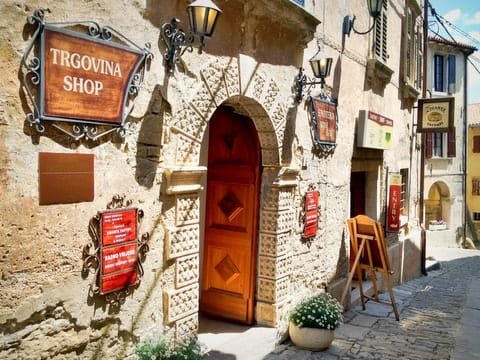
Grožnjan — This was my favorite town we visited, and one of the smallest, with a population of only 193! Grožnjan is an endlessly charming town, most famous for its summer school for musicians. We were there a bit early for the musical season, but if you visit in July or August, you’ll probably see plenty of musicians in the streets and hear them practicing in their apartments.
Grožnjan isn’t very tourism-oriented yet, which is a good thing. Because it’s somewhat difficult to get to (no public transportation runs there during the summer, and the road there is tiny, unpaved, and hilly), I have hopes that it will stay this way.
Make sure you stop at Kaya Energy Bar and Design and check out one of the best-decorated bathrooms I’ve seen in my travels.
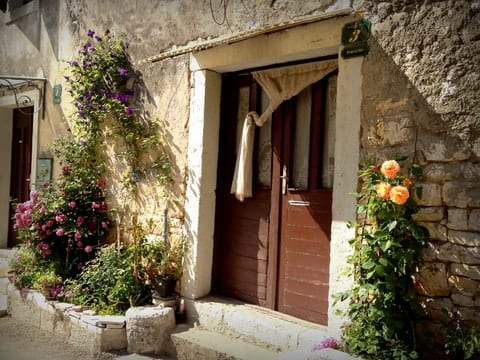
Bale — Lonely Planet called Bale “one of Istria’s best-kept secrets” in its latest guide — so don’t be surprised if Bale surges in popularity in the next year or two. I’m glad we got there when we did, because the town was pleasantly empty and filled with winding streets and rosebushes.
There’s also a great cafe/bar/restaurant/theater (seriously) called Kamene Priče which is worth visiting for the wacky decor (and hilariously misanthropic bartender).
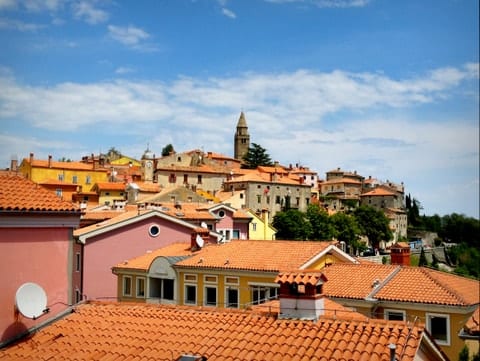
Labin — Labin was a delightful place to stop for a few hours. Being a city in the lesser-visited region of eastern Istria, we had the rainbow sherbet-colored streets to ourselves.
Labin is known for its cheap truffle pasta dishes — I got the big dish of truffle-topped fuži, an Istrian hand-rolled pasta (pictured above), for 60 kuna — or $10. In the US, it would cost at least double that.
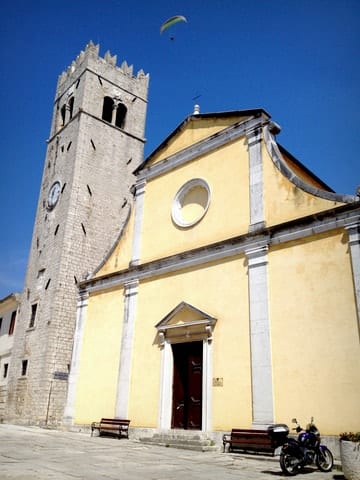
Motovun – Motovun is probably the most famous town in Green Istria. It’s perched on the very top of a mountain — and because of its unique position, it’s a mecca for paragliders (as you can see in the photo above!). Dave and I were endlessly entertained watching the paragliders fly above us as we had our lunch.
Beyond that, there’s not much to see in town, but you can get fantastic views of the countryside from the city walls.
Events and Festivals
Before we flew to Croatia, Dave discovered that we were arriving in Istria just in time for Open Wine Cellar Day! The final Sunday in May, Istria’s wineries open their doors to the public with free tastings.
We drove to Trapan Vina in the town of Šišan, just outside Pula, and sampled some delicious wines, buying a bottle of Trapan Terra Mare Ter wine to take home with us.
Beaches
Istria isn’t as famous as the Dalmatian Coast, but there are plenty of beach resorts. Istria also happens to be one of the nudist resort capitals of the world.We decided to keep the nudist resorts off the itinerary. This time, at least.

Anyway, if you’re not staying at a resort but looking for beaches, I recommend Kamenjak, at the bottom tip of Istria, south of the town of Premantura. It’s a beautiful and protected area, filled with lots of rocky beaches. And as popular as it is, even at the end of May, you could probably find a beach of your own if you’re crafty.
Seaside Bliss
I fell in love with the little seaside town of Rovinj, the most popular city in Istria.
Rovinj is definitely one of those areas that seems to be populated exclusively by tourists, and though I usually abhor towns of that nature, Rovinj is just so exceedingly charming that I can’t help but be enchanted by it!
If you’re visiting Istria, you must visit Rovinj. Whether you’re climbing the bell tower to get the best views, swimming in the coves, or just having a coffee while watching the occasional paddleboarder skim past, it’s a beautiful, relaxing, and lovely place to spend your time.
Roses
This was one of the best surprises of visiting Istria in late May — there were roses in full bloom all over the place! Vines, bushes, even giant walls filled with roses — pink, red, lavender, yellow, every color you could imagine.
The Smallest Town in the World
I’m sure there are plenty of towns that would give it a run for its money, but the Istrian town of Hum, with a population of 23, claims to be the smallest town in the world.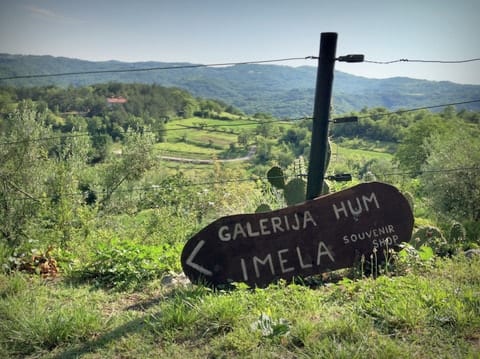
We stopped by to explore the town’s few buildings and have a coffee in town. And while Hum didn’t blow us away like the other towns did, we still enjoyed getting to see another slice of Green Istria.
The Verdict on Istria
I feel like visiting in late May, when the temperatures are warm but the tourists aren’t that bad, was a great time of year to go — but keep in mind that the Adriatic Sea doesn’t heat up until July or August. If you’re not looking to swim too much, or if you don’t mind cold water, you’ll be very happy visiting in late May.I also found Istria to be much cheaper than the Dalmatian Coast — and far cheaper than what you’d pay for a similar environment in Italy or France. Croatia may be discovered by the masses, but it’s still a bargain compared to much of Western Europe.
And best of all, though it seems like we did so much, we only scratched the surface of what Istria has to offer. There’s so much more to discover in this region, and I highly, highly recommend that you visit this little part of Croatia!
No comments:
Post a Comment